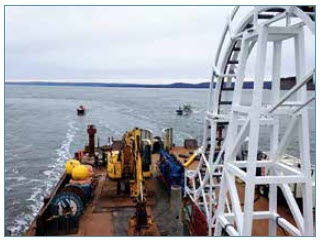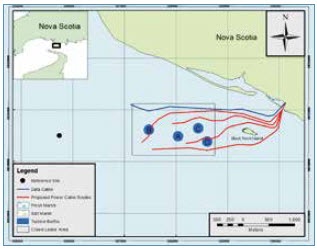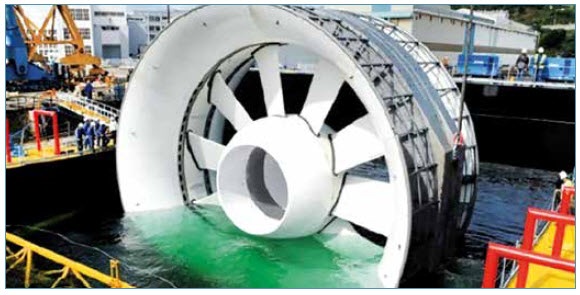 |
Nicholas Fyffe Site Development Manager |
 |
|
The ocean energy sector needs the first precommercial projects in the water, and your organization has a leading role worldwide, could you give some information of your short to medium term plans given the actual conditions? Nicholas Fyffe: Emera Inc. is a geographically diverse energy and services company headquartered in Halifax, Nova Scotia with $9.07 billion in assets and 2013 revenues of $2.2 billion. The company invests in electricity generation, transmission and distribution, as well as gas transmission and utility energy services. Emera’s strategy is focused on the transformation of the electricity industry to cleaner generation and the delivery of that clean energy to market. Emera has investments throughout north-eastern North America, and in four Caribbean countries. Emera Inc. have partnered with OpenHydro to form Cape Sharp Tidal which will facilitate the development of tidal energy projects in the Bay of Fundy, NS. The group will initially deploy two grid connected 2 MW OpenHydro turbines at Berth D at the Fundy Ocean Research Centre for Energy (FORCE) in 2015, see Figure 1. Following those first deployments, the plan is for Cape Sharp Tidal to have developed 16 MW of tidal energy by 2017, 50 MW by 2019 and 300 MW after 2020; subject to obtaining the necessary regulatory approvals. |
|
Project development involve a wide variety of risks, including technical, regulatory and financial, could you describe which are the most critical ones you have encounter/are encountering and how could they be overcome?
Nicholas Fyffe: One of the biggest risks tidal energy project developers are facing in Canada is the uncertainty surrounding regulatory and permitting processes to secure sites for development of commercial scale tidal energy arrays. Currently the FORCE area is the only site in the Bay of Fundy with a Crown Lease for tidal energy development. This lease allows the four berth holders at FORCE to install turbines (up to 5MW in total for the site) and have them grid connected, however the path for building up to 50 MW and eventually 300 MW of tidal energy outside of the FORCE crown lease area in the Bay of Fundy has not yet been defined by the relevant regulatory and legislative bodies. This gives rise to uncertainty in the scheduling and financial aspects of project development and prevents any significant investment being made in a project site that is not licensed or does not have a clear path to being licensed. The Nova Scotia Department of Energy has recently begun developing legislation to provide a framework process by which project developers can propose to develop a tidal energy site and receive not only the rights to develop that site, but also the environmental consents, in conjunction with federal requirements, that are necessary to support development of large scale tidal energy arrays in the Bay of Fundy.
As tidal energy projects increase in size, the economies of scale obtained will reduce the resulting levelised cost of energy, however the additional infrastructure required to support construction, operation and maintenance of these larger projects will need to be carefully developed to ensure unnecessary cost is not re-introduced. The build-up of this supporting infrastructure is essential to the success of tidal power plants. Suitable port facilities providing loading equipment, fuelling services, road access etc. in close proximity to tidal energy sites are essential as a base of operations for a tidal energy site. To enable the development of this infrastructure, the government at both a Provincial and Federal level should identify the needs of the industry and the infrastructure that can be developed. The government must build confidence and promote opportunities in the market to encourage private sector investment alongside grants and other funding opportunities that can be provided to support development. Providing certainty around the regulatory process will have a positive impact; if the government can establish a robust process and grant commercial licences for tidal energy sites then this will send a clear message to the market, enabling investment. Timeliness is of paramount importance. Realistic timelines for granting of licences and subsequent development of tidal energy sites are critical for investors to maintain confidence in the industry.
Technical challenges exist where there is a lack of operational experience in the harsh environments and high flows of a tidal energy site. The long term effect of exposure to subsea equipment, cables and connectors in these extreme environments is uncertain. Frequent and unplanned repair and maintenance of these components could escalate costs significantly, therefore it is essential that systems are robustly designed to ensure cables and equipment are adequately able to withstand damage from movement and vibration in high energy flows. There must also be careful consideration given on how to install, maintain and operate a subsea cabled grid connecting multiple turbines and other transmission equipment in a way that provides quality grid compliant power.
If support measures are put in place in order to overcome those barriers, can you identify the responsible stakeholders for delivering solutions, such as, governments, supply chain, research sector, etc and what would be the expected improvement in terms of your project pipeline and cost reduction
that could be achieved?
Nicholas Fyffe: Certainly when looking at the uncertainty surrounding regulatory and permitting processes, the responsibility for leading a solution is borne by government and other regulatory bodies. The government must develop and provide a licensing system which reduces complexity in the development process by removing the need for multiple permits at a site and by providing a clear application and review process. The lack of a definite timeline or an overtly lengthy process for gaining a site license is also problematic and makes it difficult to build a business case for investing in the development of tidal energy in Nova Scotia. There is a wealth of experience available from offshore renewables in other jurisdictions such as Europe as well as offshore oil and gas in Canada and the USA, which can be used by the government to mold the licensing system into a robust platform for tidal energy development. There is also a responsibility for other stakeholders, such as project developers and service providers, to provide input into developing the regulatory process to ensure that the path for securing and developing sites is not encumbered by requirements that significantly delay or increase cost to a point where tidal energy projects are no longer feasible. On the other hand, it is also necessary to have environmental groups, local communities and local industry engaged in the regulatory process to ensure tidal energy sites are developed responsibly with regard to the environment and the interests of all stakeholders.
|
The government can identify the supply chain needs of the industry and engage with suppliers to market their capabilities to project developers and other tidal energy participants which will aid in the development of the supply chain. Project developers also play an important role in engaging with existing local industry to establish the supply chain that will be required to support large scale tidal energy farms. To facilitate the ongoing operation of tidal power plants there is a distinct opportunity for communities in the area local to tidal energy resources to create turbine manufacturing and servicing plants and upgrade existing local harbour infrastructure to support the offshore operations. Colleges and universities local to the area should also be engaged to provide opportunities for education and training in subjects and trades relevant to tidal energy to ensure skilled workers are available to support the industry. Overcoming these challenges will reduce uncertainty in tidal energy project development and help to stabilize project costs and timelines. |
 Figure 2 - Cable Laying at the FORCE Site (Source: FORCE) |
How do you see that international collaboration could accelerate ocean energy growth and what, specifically, is the role that you would like OES to play in supporting the development of ocean energy?
Nicholas Fyffe: In order for international collaboration to significantly accelerate the industry, it is imperative that the focus of collaborative efforts move from the energy converter itself to the more costly aspects of a tidal energy project, such as balance of plant, supporting infrastructure and operation and maintenance techniques. If more emphasis is placed on developing solutions in these areas, then costs can be reduced and industry growth can be more easily achieved.
Many of the challenges faced by the tidal energy industry are encountered regardless of jurisdiction. Internationally, tidal energy industry players are developing solutions and overcoming hurdles in a complementary manner, so that experience and knowledge can be shared for mutual benefit which will allow unnecessary costs and delays to project timelines to be avoided.
|
|
To give a specific example, Scotland is further advanced than Nova Scotia in its approach to regulatory and permitting of tidal energy sites with 600MW of tidal energy development rights being granted for the Pentland Firth and Orkney. The current efforts by the Nova Scotia Department of Energy to develop a licencing system in Nova Scotia would benefit from international collaboration and sharing of lessons learned from the Scottish experience. Conversely, tidal energy projects in Nova Scotia have the potential to offer to international collabo-rators opportunities for cost reductions, and efficiencies in installation, operation and maintenance of tidal energy devices and subsea grid infrastructure, if reliability for these techniques can be proven in the Bay of Fundy which is generally regarded as one of the harshest tidal energy environments in the world. |
OES could, of course, play an important role in facilitating this international collaboration through industry events, conferences, workshops and business to business matchmaking. By working with the offshore wind industry and other relevant industries to get better information and knowledge on deployment and retrieval techniques, operation and maintenance considerations, subsea cabling and infrastructure experience etc., OES could serve as a single source of information for the industry. It is important also that the wider ocean and offshore industry have significant involvement in developing ocean energy. Although tidal technology and project developers are fundamental to these efforts, research and development through collaboration with offshore industry, utilities, and government is required to provide solutions that will enable the success of tidal energy as an alternative source of renewable energy.





